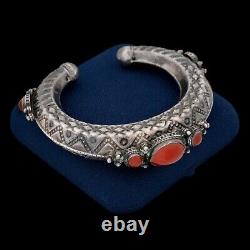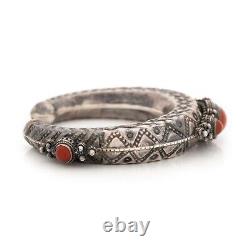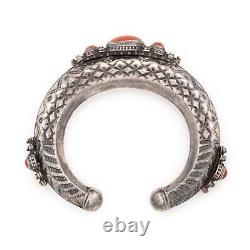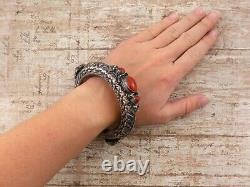
- Home
- Brand
- Art Nouveau (4)
- Bold Bloc Design (6)
- Camerden Forster (2)
- Erhard & Sohne (2)
- Grès De Charenton (2)
- Handcrafted (2)
- Handmade (7)
- Herve Lelong (6)
- Karlsbad (3)
- Kayserzinn (4)
- Makenier (3)
- Mundia (2)
- No Brand / Generic (11)
- Nsp (2)
- Rosenthal (2)
- Starling (6)
- Unknown (2)
- Villeroy & Boch (4)
- Vintage (4)
- Wilhelm Kagel (2)
- Other (3253)
- Features
- Gender
- Material
- Period
- Size
Antique Vintage Art New Silver Sterling Yemeni Cornaline Giant Sleeve






Antique vintage art New Sterling silver Yemeni giant cornaline cuff. This product sheet is originally written in English. Please find below a machine translation in French.
If you have any questions please contact us. We have similar Yemeni and cornaline items, which would marry well with this room, on sale this week. Description of the object by: cait p. Art Nouveau circa 1890 - 1910. Markings: "made in Israel" inside the group, tested, guaranteed.
Weight in grams: 54.4 grams. Type of metal: sterling silver. Major stone/color measurements: there are two sizes of stones: one measuring 11.65 mm long by 17.4 mm wide, while the others measuring 6.55 mm in diameter; and a semi-translucent orange colour. Measurements/color of the accent stone.Stone treatment: the stone or stones seem not to have been treated, but we are not certified gemologists. The stones were tested and guaranteed using a professional refraction, heat and hardness tester presidium duo. Stone sizes: carved and polished cabochon. Portable length and inner circumference without counting the gap of the armband: 5.95. The gap of the brassard adds a supplement: 0,90.
Total portable length and inner circumference: 6.85. Bracelet width: 0.45" to 0.65". The band measures from 0.40" to 1.0" depth. Type of closure / clasp: The bracelet is intended to be worn on the wrist through space. Link type: rounded and polished sterling silver. Handcrafted at the time of Art Nouveau in Israël in Yemeni and Bedouin styles. The bracelet is made of sterling silver. 925, which has been transformed into a heavy cuff strap using repelled metal working techniques. The band of the bracelet is hollow and shows geometric patterns in relief in the style of Yemeni and Bedouin jewelry. The outside of the bracelet is also decorated with orange cornaline stones, which contrast nicely with the fresh color of silver. This huge and heavy bracelet was most likely made in Israël for a local Yemeni population. Damage: wear adapted to age. The tarnishing of sterling silver gives this coin an ancient quality which, in our opinion, is very beautiful. This list is for the article only. Not all photo displays and/or accessories are provided with your purchase.It was very true because of the beautiful designs that came out of this period. This time was centered on women, and the beauty of nature and the pieces were often voluminous. The enamel was a standard material used in art nouveau jewellery, as the period was more focused on the importance of design than on the materials used to create it. The art nouveau period took place before the beginning of the First World War, when mass manufacturing took over the production of many products, including some jewellery. Ancient Turkish, Islamic and Bedouin jewels all share similar ancestral and stylistic roots and have been mutually influenced by trade for many years.
This can be largely attributed to the expansion of the Ottoman Empire, which valued art and crafts and promoted the pursuit of Arab arts and calligraphy. The reign of Ottomans in the xvie and xvii centuries introduced Turkish motifs into Islamic motifs and nomadic Bedouin culture, merging a range of styles into beautiful arabesques; repeating rhythmic motifs, which often include floral and organic geometric motifs. Cornaline is a beautiful form of calcedony precious stone used to create jewelry for nearly 5000 years. It is an opaque-looking stone that varies in red shades ranging from pale orange to intense blood red, almost black. Called the stone of kings, the cornaline was well suited to sculpture and was often used in seal rings by the great ancient civilizations. The repulse began as an old metalworking technique dating back to the 3rd century BC, involving a malleable metal that was hammered on the back to create an image on the front. Examples are found all over the world; the greek, the gypsy, and even the hopwell periods in the southeastern American. Inverse-side hammering has also been used to add details to the front, creating complex patterns with grooves, indentations and pipes. The piece was then carefully polished to create a hollow and catchy treasure. All items are shipped within one business day of receipt of payment.We do not underestimate packages for customs, please do not ask us to do so. What you pay is what we will ask on your customs form. Please take this into account before placing your bid. If you need more time to pay, please contact us before you bid.
Ancient Turkish, Islamic and Bedouin jewels all share ancestral and sty roots. This item is in the category "Jewels, Watches\ Jewellery\Others". The seller is "abeautifultimeco" and is located in this country: us. This item can be shipped to the following country: france.
-
Style: bracelet
- modified object: without
- metal purity:.925 Jewellery department: fine
- metal: fine money
- country/region of manufacture: israël Type of clasp: bracelet Type: bracelet Mark: - no mark/generic - Dominant stone: cornaline

